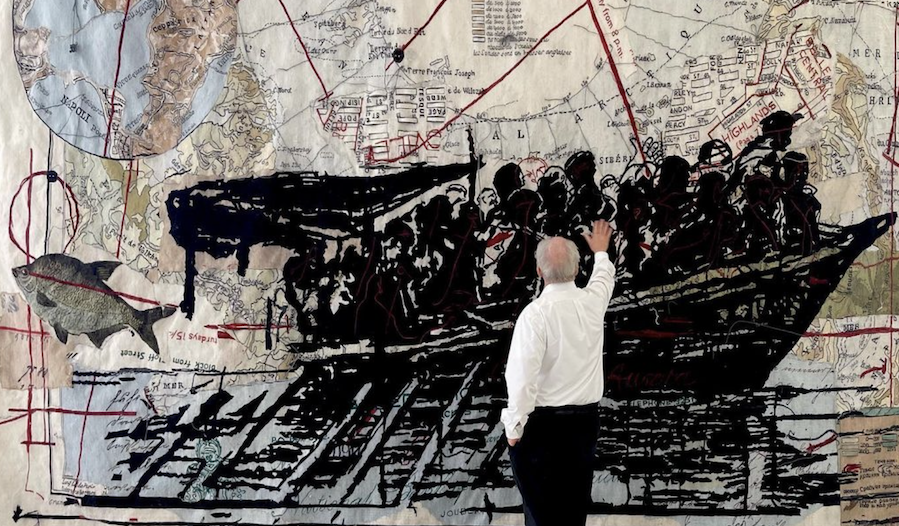
OPERATIC EPICS
Image: William Kentridge in front of Carte Hypsométrique de l’Empire Russe, 2022. Hand-woven mohair tapestry. 400 x 600 cm. William Kentridge Studio, Johannesburg © William Kentridge.
In 2001, the acclaimed South African artist, William Kentridge, began making tapestries, in collaboration with the Stephens Tapestry Studio. Raw mohair from Angora goats farmed in the Eastern Cape, is carded, spun, and dyed in Eswatini. The threads are then transferred to the looms at the studio in Diepsloot, on the outskirts of Johannesburg.
 Image: Witwatersrand Horse, from Triumphs and Laments. Tapestry. William Kentridge. Courtesy of Stephens Tapestry Studio
Image: Witwatersrand Horse, from Triumphs and Laments. Tapestry. William Kentridge. Courtesy of Stephens Tapestry Studio
Kentridge’s preparatory drawings are adapted, annotated, and set behind the vertical strings that form the skeleton of the tapestry. Teams of up to five skilled weavers then work at each loom, translating the intricate design into the new medium. The process can take up to eight months to complete.
 Image: Spinner. Tapestry. William Kentridge. Courtesy of Stephens Tapestry Studio
Image: Spinner. Tapestry. William Kentridge. Courtesy of Stephens Tapestry Studio
In 2010, Kentridge explained his attraction to the nature of tapestries and the process of tapestry making:
Video: Excerpt from William Kentridge: Anything Is Possible, 2010. Art21.
Carte Hypsométrique de l’Empire Russe, the largest tapestry made by Kentridge and the Stephens Tapestry Studio to date, was specially made for the major solo exhibition currently at London’s Royal Academy.
 Image: Carte Hypsométrique de l’Empire Russe, 2022. Hand-woven mohair tapestry. 400 x 600 cm. William Kentridge Studio, Johannesburg © William Kentridge.
Image: Carte Hypsométrique de l’Empire Russe, 2022. Hand-woven mohair tapestry. 400 x 600 cm. William Kentridge Studio, Johannesburg © William Kentridge.
The central image of the boat is based on a drawing, Migrants and Prisoners, that Kentridge conceived for a monumental frieze, Triumphs and Laments, created on the banks of the Tiber, in Rome, in 2016. The image of the perilous journeys migrants undertake serves as a reminder of the terrible challenges that continue to confront the world we live in.
The Royal Academy show spans Kentridge’s mastery of media- from etching, drawing, collage, film, and sculpture to theatre, opera, dance, music, and a room of six monumental tapestries. For a guided glimpse into ‘an operatic epic of a show’ (The i), the RA has created a small video tour.
 Image: The William Kentridge tapestry room at the Royal Academy.
Image: The William Kentridge tapestry room at the Royal Academy.
You’ll need to hurry to see the works up close. The exhibition closes on 11 December, 2022.
 Image: France: North-West Section. Tapestry. William Kentridge. Courtesy of Stephens Tapestry Studio
Image: France: North-West Section. Tapestry. William Kentridge. Courtesy of Stephens Tapestry Studio
